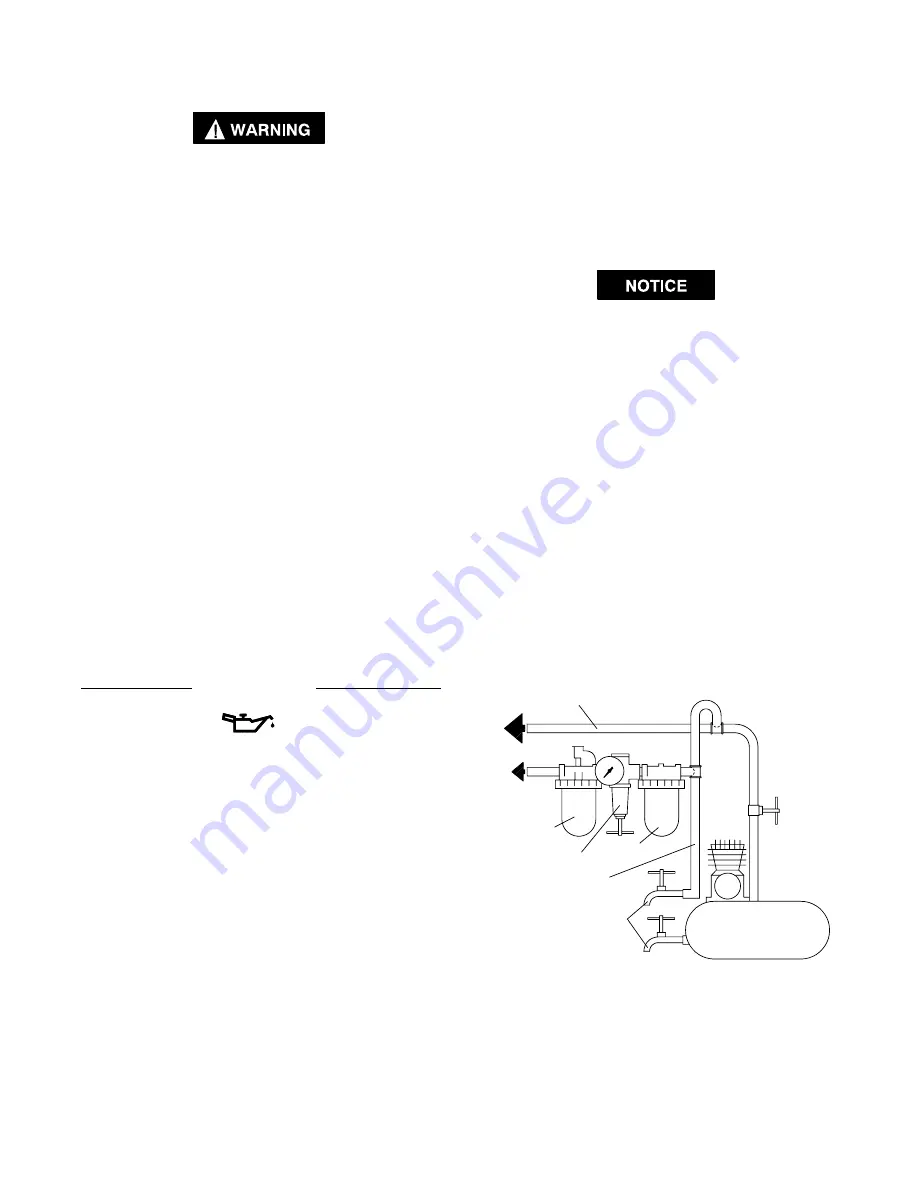
3
ADJUSTMENTS
Accessory Installation
Always turn off the air supply and disconnect the air
supply hose before installing, removing or adjusting any
accessory on this tool or before performing any
maintenance on this tool.
For Plain–Type Retainer No. HH1–1190
Grasp Retainer and remove Lock Spring from the Retainer
groove. Remove Retainer from Barrel. Raise chisel until the
oval, integral collar on the chisel shank clears the alignment
grooves inside the Retainer. Rotate the chisel 90
°
.
The chisel can now be removed from the front of the Retainer.
To install the chisel, insert the shank of the chisel into the
front of the Retainer until the chisel can be turned 90
°
,
allowing the oval, integral collar on the chisel shank
to drop and rest on the shoulder in the retainer.
Attach the Retainer to the Barrel by aligning the slot in the
Retainer with the groove in the Barrel. Insert the Lock Spring
through the slot in the Retainer body and push the Lock
Spring around the Barrel and Retainer until the Retainer is
secured to the Barrel.
For Rubber Buffered Type Retainer No. HHW1–300 (for
use with threaded barrel)
Grasp the Retainer (28) and unscrew it from the Barrel (17)
against the pressure of the Retainer Lock Spring (27).
Remove the buffer and the chisel from the rear of the Retainer.
The Buffer will split to allow the use of a wide chisel.
To install a wide chisel, pass the shank of the chisel through
the hole in the Retainer and by opening the split in the buffer,
fit it around the chisel making sure that the shoulder of the
chisel locates in the large counter bore of the buffer. Slide the
assembly into place in the threaded end of the Retainer.
Moil point and narrow chisels can be removed and
installed without removing the buffer from the Retainer.
Align the end of the chisel with the Nozzel (21) and thread the
retainer onto the Barrel. Tighten the Retainer clockwise on
the Barrel until the Retainer Lock Spring can be seen or heard
to locate in place in the recess in the barrel thread. Check
correct engagement by trying to rotate the Retainer. If
significant resistance is felt, the Retainer Lock Spring is
correctly engaged. If no significant resistance is felt, rotate
the Retainer until Retainer Lock Spring engages properly.
PLACING TOOL IN SERVICE
Hammers are coated inside and out with rust–resisting oil
before leaving the factory. Before using the Hammer, remove
this oil by dipping the tool in a suitable cleaning solution to
wash the oil from the exterior. Pour about 6 cc of a suitable
cleaning solution into the air inlet and attach the air hose.
Insert a Chisel into the Hammer and while holding the chisel
blade against the work or a relatively solid object such as a
plank or timber, operate the tool for about 15 seconds. Dry
the tool immediately after cleaning, pour 3 cc of
Ingersoll–Rand No. 10 Oil into the air inlet and again operate
the tool for 5 seconds to lubricate all working parts.
LUBRICATION
Ingersoll–Rand No. 10
Always use an air line lubricator with these tools.
We recommend the following Filter–Lubricator–Regulator
Unit:
For USA – C18–03–FKG0–28
Before attaching the air hose, place about 3 cc of
Ingersoll–Rand No. 10 Oil into the air inlet. This should be
done each day, even when an air line lubricator is used.
During the working day, check the tool to ensure that the
retainer components are lubricated.
After each two or three hours of operation, if an air line
lubricator is not used, disconnect the air hose and pour about
3 cc of Ingersoll–Rand No. 10 Oil into the air inlet of the tool.
If the action of the Hammer becomes sluggish, pour about
3 cc of a suitable cleaning solution into the air inlet and run
the tool for not more than thirty seconds. Immediately after
flushing the tool, pour about 3 cc of Ingersoll–Rand No. 10
Oil into the air inlet and run the tool for about thirty seconds
to lubricate internal parts.
Before storing a Hammer or if the Hammer is to be idle
for a period exceeding twenty–four hours, pour about
3 cc of Ingersoll–Rand No. 10 Oil into the air inlet and operate
the tool for 5 seconds to coat the internal parts with oil.
MAIN LINES 3 TIMES
AIR TOOL INLET SIZE
TO
AIR
SYSTEM
TO
AIR
TOOL
LUBRICATOR
REGULATOR
FILTER
BRANCH LINE 2 TIMES
AIR TOOL INLET SIZE
DRAIN REGULARLY
COMPRESSOR
(Dwg. TPD905–1)




































